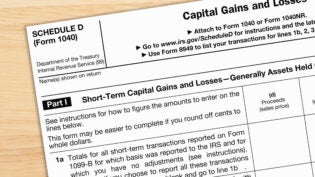Tax Planning for Pass-Through Business Entities After Tax Reform
By: TaxConnections

Tax planning under the TCJA for pass through entities is a post for small business owners everywhere paying US income taxes.
Now that the Tax Cuts and Jobs Act (TCJA) is in full swing, many of you have been clamoring for tax planning strategies. This post addresses some essential aspects of the Act and suggest some strategic implications to be used for planning purposes.
One of the most significant changes coming out of the TCJA are the new tax rates:
- The individual tax rate is reduced to a maximum 37%.
- The tax rate for pass-through entities can be reduced by 20%.
- The corporate tax rate is reduced from 35% to as low as 21%.
As a result of these new tax rates there is a growing debate over whether a business should be organized as a pass-through entity or a full blown ‘C’ corporation.
Families with multiple businesses in various life cycle stages are compelled to think very carefully about tax implications associated with their ‘portfolio’ of business entities.
On the surface it appears that if your individual tax rate is higher than that of a C corporation (21%) you might be best served adopting a C corporation structure for your business affairs. Whereas a partnership or S corporation might be a better choice for those with an effective rate lower than the 21% corporate rate.
But the analysis dives a bit deeper.
Putting aside the idea of double taxation associated with dividend distributions out of a ‘C’ corporation, it is not that surprising to observe that this type of business structure ‘seems’ generally preferable over a partnership or an S corporation. I personally prefer the anonymity it can afford.
In fact my drunk uncle whilst pontificating at our last family barbeque asserted boisterously that all natural US Citizens should be given at birth their own corporation … and I could not disagree … for a variety of reasons.
However for you kind readers, when the double taxation of the dividend distribution is taken into account, a C corporation may not necessarily be preferable.
Nevertheless all C corporations are now taxed at the same flat rate of 21% regardless of size. This means that a mom-and-pop store is treated the same as a large publicly traded corporation. It may drive small businesses toward an S corporation or a partnership where the business profits could potentially be taxes at the lowest possible bracket, 10%.
The beauty of the TCJA is that changes to the individual and corporate tax rates create opportunity for astute taxpayers to restructure business entities and/or shift income between between wages and pass through profit for the purpose of minimizing total tax liability.
- An individual taxpayer may choose to form a C corporation to structure their business affairs because income will be taxed at the lowest rate – 21%.
- Partnership or S corporation income is likely to be the second choice because of effective individual tax rates.
- Individual wages can subject to the highest marginal tax rate of 37%.
A strategy of this nature requires insight into the intentions for the income both short and long term with the ultimate questions being are you distributing or reinvesting.
Below are some basic examples explaining different opportunities.
Example 1: Li Li & CJ are in the restaurant business.
Li Li & CJ (married taxpayers filing jointly) are attempting to understand three different tax rate options depending on their respective roles in the business.
- Li Li is a hostess and her husband CJ is a cook. Collectively they earn $10,000 as employees. If they have no ownership interest in the restaurant their collective $10,000 wage is subject to the individual income tax rates based on their total income. Because they have income from other sources, their maximum tax rate is 37%. They pays $3,700 of income tax on those earnings ($10,000 * 37%)
- Li Li & CJ own the restaurant in a partnership. Their collective share of profit is $10,000. Excluding self-employment tax for argument sake the $10,000 profit is taxed at a maximum effective rate of 29.6% (20% pass through reduction of 37% maximum rate) or $2,960 (10,000 × 29.6%).
- Li Li & CJ incorporate the restaurant. The restaurant’s profit is $10,000, and it does not distribute any cash dividends to shareholders. Excluding employment tax for argument sake, the C corporation pays corporate income tax at a rate of 21% under the TCJA, i.e., $2,100 (10,000 × 21%).
In this example Li Li & CJ could take advantage of the 21% corporate tax rate and pay less income tax out of pocket provided their C corporation does not pay out cash dividends.
Example 2: S corporation or C corporation.
Li Li & CJ also own two retail stores:
- a marijuana dispensary and
- a confectionary
For strategic purposes they happen to be next door to each other.
The profit from the dispensary operation is to be reinvested back to the business for expansion, as after all this is Colorado. As such no dividends will be distributed. This business earns $100,000 in profits but distributes no cash dividends.
The profit from the confectionary operation is to be distributed. It also earns $100,000 in profits and distributes the entire $100,000 to the owners.
An optimal business structure to minimize income taxes for these two operations under the TCJA is…
- Organize the dispensary operation as a C corporation to take advantage of the 21% tax rate. Because the dispensary operation does not plan to distribute its profits as a dividend, it will not be subject to double taxation and the total tax liability is $21,000 ($100,000 × 21%).
- Organize the confectionary operation as an S corporation because its profits will be taxed only once at an individual rate. This structure avoids double taxation while taking advantage of the 20% deduction as a pass-through entity at a reduced effective tax rate.
This example demonstrates that a pass-through entity and a C corporation have their own advantages and disadvantages. Which ‘structure’ is more beneficial depends on whether the profits will be distributed as dividends.
At issue is that in reality ALL businesses migrate through a life cycle. Business structures can and often times do change to take advantage of matters involving taxation at various stages in their respective life cycles.
You can indeed have both a ‘C’ corp and an ‘S’ corp based on where each respective business is in its life cycle and what the future holds.
Without distributions, a C corporation is more beneficial; whereas, if distributed, a pass-through entity could be preferable.
Additionally as a result of the TCJA, a pass-through entity may generally deduct 20% of its ‘qualified’ business income.
As a result, assuming you are otherwise in the highest marginal tax bracket your tax rate is effectively reduced from a maximum of 37% to 29.6%.
According to Section 199A(c)(1) there are several limitations to this deduction making the taxation on a pass-through entities overtly complicated.
A “qualified trade or business deductible amount” is generally the lesser of
- 20 percent of the taxpayer’s qualified business income from trade or business; or
- a “W-2 wages/qualified property limit,” which is the greater of
- 50 percent of the W-2 wages of the trade or business; or
- the sum of 25% of the W-2 wages of the trade or business, plus 2.5 percent of the unadjusted basis immediately after acquisition of all qualified property of the trade or business.
The term “qualified business income” means, for any taxable year, the net amount of qualified items of income, gain, deduction, and loss with respect to any qualified trade or business of the taxpayer. Such term shall not include any qualified REIT dividends or qualified publicly traded partnership income.
The term “qualified trade or business” means any trade or business other than
- a specified servicetrade or business, or
- the trade or business of performing services as an employee.
What this means is the service income exception has important strategic implications:
- the income deduction is granted only to pass-through entities.
- not all ‘specified service income’ you derive is not entitled to the 20% deduction.
- the deduction phases out with income
- Treasury Regulations have not been promulgated as of this posting.
According to IRC 1202(e)(3)(A) a ‘Specified Service Business’ is defined as any trade or business involving the performance of services in the fields of:
- health
- law
- accounting
- actuarial science
- performing arts
- consulting
- athletics
- financial services
- brokerage services
- any trade or business where the principal asset of such trade or business is the reputation or skill of 1 or more of its employees.
Architects and Engineers are excluded!
Example 3: Wage vs. profit.
Let’s say for argument sake that Li Li operates a retail vinyl record shop for beatniks and hipsters as an S corporation, but she is also a mystic and an accountant. She provides fortune telling services & accounting services interchangeably to her customers in an office located in the record shop.
In this scenario is Li Li a business owner attempting to earn a profit selling records or a visionary telling accounting fortunes for hire? If the former is true, the profit is entitled to the 20% deduction; whereas, if the latter is true, she may not necessarily be able to take the 20% deduction.
Her tax status is ambiguous until the US Treasury promulgates regulations.
It would be more beneficial for Li Li to claim the income of her visionary service as part of the income of the entire record store. In this case Li Li might be inclined to attempt to shift her individual wage income to the S corporation and write herself a broad job description.
There is a limit to how one can use the pass-through entity deduction. The term “combined qualified business income amount” generally means an amount equal to the sum of the amounts for each qualified trade or business carried on by the taxpayer, plus 20% of the aggregate amount of the qualified REIT dividends and qualified publicly traded partnership income of the taxpayer for the taxable year.
- This section’s purpose is to take into account the case of a real estate investment with few employees who have little W-2 wages, but significant investment.
- Under these circumstances, a real estate investor is also eligible for the deduction. Qualified property means depreciable tangible property for the qualified trade or business.
- The limit does not apply to a single taxpayer with taxable income below $157,500 (or $315,000 for a married couple filing a joint return.)
- This threshold amount is between the 24% and 32% tax brackets.
- It means a taxpayer at the 24% or lower tax bracket is not subject to the above limit on the deduction.
- Any income above the limit is subject to an individual’s tax rate up to 37%
Example 4: Limit on deduction of a pass-through entity
Li Li & CJ operate a supermarket as an S corporation. The supermarket receives $2 million in gross sales revenue and pays $1 million in cost of goods sold.
- It pays $200,000 in wages, resulting in qualified business income of $800,000 ($2,000,000 – $1,000,000 – $200,000).
- The qualified business income is $800,000 leading to a qualified business income deductible amount of $160,000 ($800,000 × 20%).
- However, the deduction is limited to 50% of wages, i.e., $100,000 ($200,000 wages × 50%).
- Thus, the qualified business income deduction is $100,000. The taxable income is $700,000 ($2,000,000 – $1,000,000 – $200,000 – $100,000).
- The tax liability is $259,000 ($700,000 × 37%).
Example 5: Rental Real Estate
Li Li and CJ bought a commercial property to house their restaurant for $170,000 in cash in 2017 with a land value of $30,000. They forecast $5,000 of taxable income after depreciation as follows:
- Net business income $5,000
- Other income $220,000
- AGI $225,000
- Less Standard Deduction -$12,000
- Taxable income $213,000
- Qualified Business Income (QBI) Deduction is $1,000
- QBI Deduction is the lesser of:
- 20% of net business income ($5,000 * 20% = $1,000)
- 20% of taxable income ($225,000 * 20% = $45,000), or
- Greater of:
- 50% of W2 wages ($0 * 50% = $0)
- 25% of W2 wages + 2.5% of unadjusted cost basis of assets (($0 * 25%) + ($140,000 * 2.5%) = $3,500)
Conclusion:
This post investigates how three different tax rates, 37%, 29.6%, and 21%, can create opportunity for astute tax professionals. For example, whether you should form an S corporation or C corporation may depend on whether the C corporation intends to distribute cash dividend.
The taxation on a pass-through entity has become quite complicated under the TCJA. In addition to the reduction of its taxable income by 20%, it is applicable to business profits but is also limited by wages. As a business owner you must now more so than ever carefully consider your wage.
The implication is that the TCJA encourages a business owner to pay out more wages so as to increase the deduction amount, but there are limits to this amount as well and is not to be treated as a panacea.
Other planning ideas include:
- Increasing qualified property by purchasing equipment and real estate.
- Spinning out or merging businesses based on service and non-service operations and/or spinning out real estate to a standalone entity.
- Recapitalizing businesses shifting leverage to service businesses.
Have a question? Contact John Dundon.
Author: John Dundon is enrolled with the United States Treasury Department to practice before the IRS, governed by rules stipulated in United States Treasury Circular 230. As a Federally Authorized Tax Practitioner and a tax appeals specialist my Enrolled Agent License #85353 is issued by the United States Treasury. With this license I work for U.S. taxpayers everywhere to resolve tax matters and de-escalate stress about taxes or tax disputes for individuals and corporations with federal and state issues.












